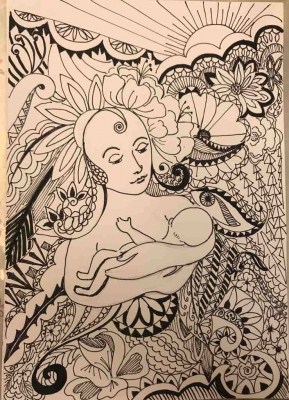By S. Ravi
New Delhi, March 15: The all-women group art show “Naari Tu Narayani”, currently on at the Art Life Gallery is a fitting tribute to womanhood. Highlighting the contributions, achievements and feelings of women, the eight artists bring alive through their acrylic paint on canvas works, makes the viewer ponder.
There participating artists are Anjali Mittal, Anjana Birla, Arun Prabha, Anita Goyal, Neelam Sachan, Sarojini Dutta, Shankari Kundu and Shikha Ojha.
Organised to celebrate the International Women’s Day (March 8), the 24 acrylic paint on canvas artworks are on view till March 16. Elaborating on the theme, the show’s curator Priti Bajaj, observes, “Women are the creators and nurturers and all the women artists have portrayed this in their works. Whether it is the flowers by Mittal or the women power that Birla has portrayed or women earning the livelihood by Prabha, all artists have focused on the various aspects of women’s life.”
Constituting half the population of the world, the share of women in all aspects of society is crucial. That is what Prabha’s puts across in her paintings. The finely drawn “Fish Seller” showing women selling the catch not only brings out the beauty of the figures but also of the background of palm trees. This is true for the “Lady Farmer” also wherein one sees three women, with bundles on their head returning from a day’s of hard labour. The accompanying child and the small bundle being carried by one woman, gives an authentic touch!
Prabha equates anything that women do “is like a prayer for our family and the world”. Bajaj remarking that, “women pitch in every form to support their family and folks,” asserts that this needs to be acknowledged and appreciated.
Bringing out varied dimensions of womanhood are the works by the self-taught Dutta. Her black and white “Mother and Child” radiating maternal love, shows a mother with happiness brimming in her eyes as she safely holds her child in her arms. The sun rays in the background and the floral and petal patterns around the mater, make it an enchanting sight!
“Mother is the epitome of love and womanhood. The child with the mother is the ultimate expression of love in the life of a woman,” observes Dutta. Her “Bride” and “Waiting Women” put across the other roles donned by women. The former is exquisitely drawn with her face partly veiled and covering one eye. In the other work a homemaker while finishing her chore eagerly waits for her loved ones to return. Commenting on these works, Bajaj says, “a woman can have many dimensions to her personality and yet she is considered weak as compared to men. Time we revisited our societal notions.”
Sachan’s “Female Literacy” is a woman immersed in reading in a verdant surrounding while her “Dancing Mood” depicts a woman with wings of angel performing with gay abandon. While both are well made, it is her “Melancholy” which stands out. The well- drawn female features and the curly hair, all portray beauty yet shows a certain despondency. “Sadness is reflected in the eyes. More so with women, who are more emotional than men. Hair is an important part of a woman’s face and any woman with dishevelled hair cannot pretend to be happy. It is one of the giveaways of her mental makeup,” avers Bajaj.
Mittal and Kundu use flowers and trees to bring out womanhood. The former’s “Flower 1, 2 and 3” through a riot of bright colours show different flowers. “Flowers are colourful, beautiful, soothing and bear seeds of progressive regeneration. Don’t you think women share the qualities with flowers?” observes Bajaj. Sharing her perspective, Mittal says “If we do not get the right atmosphere, we are likely to fade away.”
Sharing her view Kundu, a senior artist, whose “Desire” and “Tears of Hope” are part of the show adds, “Women are like trees and that’s what I have shown in my paintings. They need care and love else they are likely to shrivel.”
Giving the viewers food for thought, Birla’s “Lata Mangeshkar” and “Mother Teresa” provide women to role models to be motivated by. Both are life-like and portray the familiar smile of the two legendary public personalities. Bajaj feels that women have to look up to other women for inspiration and says “men usually can’t inspire women, reason being the different circumstances under which both the genders operate.”
Ojha’s works “Shubh-2”, “Shisha-1” and “Nisha” use beautifully etched tribal women as the subject. A gold -medallist from Lucknow University in Fine Arts, she says, “these tribal women are unaware of gender bias and have tasted equality in life and tribe.” Unfortunately, this slowly declined making the need for gender parity a must in all spheres of life.
(This content is being carried under an arrangement with indianarrative.com)
–indianarrative/

